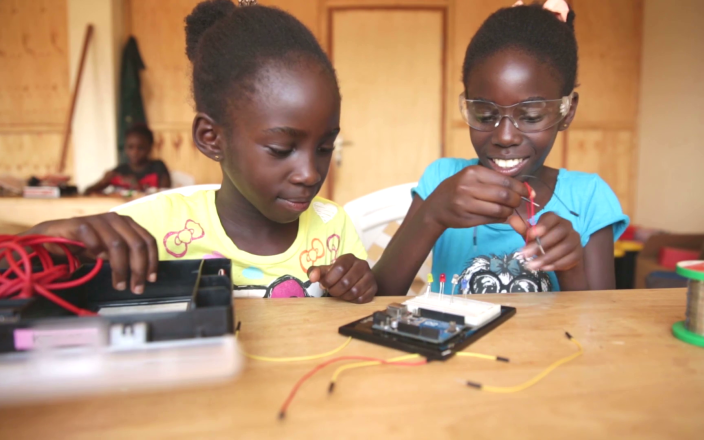Many people ask about what Fundi Bots does and how relevant it is in Uganda and why they should care.
(For those who don’t know, we are the organization that teaches kids how to build robots. We’ve been doing it since 2011).
It seems to a lot of people that all we do is build robot things, but it goes much deeper than that. We’re not here to bring fancy technology into classrooms or to just feel good about helping people.
We’re here to help improve learning and we are very serious about what we’re doing.
Uganda’s education system has been reduced to a system of memorizing information in order to pass to the next level, with very little tangible or useful benefits after school.
We’re working to change that.
Let me explain.
Fundi Bots is promoting better science education in schools and communities by providing hands-on, skills-based, project-oriented learning experiences.
Our primary tool of choice, for now, is robotics. We teach kids (and adults) how to build robots. More exciting tools are on their way and we’re expanding to other science subjects.
We work in schools and outside of schools through our Fundi Spaces in Kampala, Mbale and soon, Gulu.
BUT WHY ROBOTS?
Building a robot is a fun and exciting experience for almost everyone. I mean, who doesn’t want to build a robot? But, we use it as a very cool way to learn a lot of very important things.
Like:
1. Computer Programming.
The robots need to know what to do, where to go and how to behave, so we give them instructions through computer programming. In the process of learning how to program, kids learn how to use computers, how to design simple games and how to think logically.
2. Electronics.
The robots need to convert power from a battery into electrical signals that turn motors to move around, turn lights on and off to indicate something, or to detect obstacles and objects around them. As students learn electronics, they understand a lot more about what they are taught in school as theory and how that applies in the real, practical world.
3. Mechanics.
The robots need to physically move around or do tasks, so we teach students about gears, mechanical systems, how to improve power and speed when handling certain tasks and how machines can become more efficient and useful.
Almost all of this is taught in school as science and physics, but as theory. So we are adding an extra layer of learning that engages students better and has stronger learning outcomes for kids.
But also:
4. Soft Skills.
We discreetly integrate soft skills into our classes. Things like leadership, project management, team work, presentation and communication skills are all part of the learning process and significantly improve students’ lives and career prospects for the better.
And the truly magical bit is that once they are done, they no longer care about the robot, but they want to learn more about programming to build games and apps and animations. They want to learn about car mechanical systems or to build aeroplanes and rockets that go into space and they want to build solutions for problems they face at home and in their communities.
So at the end of the day, the robot doesn’t matter, but the journey of building the robot has significantly changed mindsets and transformed students from just waiting for class to learn into people who actively seek knowledge for the betterment of themselves and the world in general.
How does all this come together in the work we do?
We call them the three Cs.
1. Curriculum Understanding.
Through our classes, students make stronger connections between the theory and the practical and it leads to improved classroom performance. We do not focus on memorizing information to pass examinations, but on deep learning and understanding. The great side effect of this is that students end up passing examinations better.
2. Careers & Skills.
We have skills-development at the core of our learning, which means we teach using modern tools and technology that prepare students for careers from a very early age. By the time a consistent Fundi Bots student leaves high school, they are at a level comparable to many second-year Ugandan university students (and have probably done more practical learning than most university students here) and they have a significant head start in the careers they wish to pursue.
3. Community Innovation.
We encourage our students every single day to explore ways in which technology can be used to solve problems within their communities. This teaches them to harness knowledge for better good, but also creates an entrepreneurial mindset that puts power back in their hands.
80% of our work is offered free of charge to anyone, especially students from under-served regions.
20% of our work is through paid classes and programs, which helps us reach and serve thousands of students.
100% of our work is not for profit, which means every single shilling and dollar we earn goes back into reaching more people and creating better learning tools.
So, at the end of the day, the robot, while cool and fun to work with, is simply a tool to engage students and start them on a wondrous learning journey that will transform their lives, their communities and the world at large.
Onwards. Upwards.
#weAreFundi






